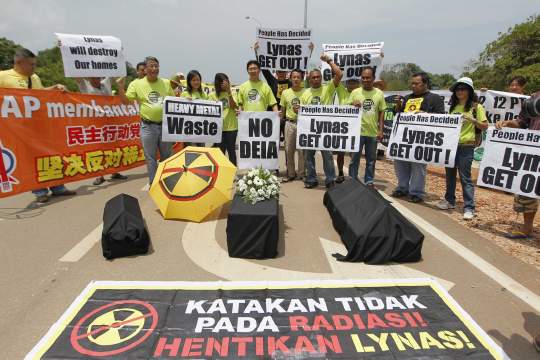The dumping of nuclear waste has become a hot button issue again after the controversial plan for a permanent storage facilitate at Muckaty Station was dropped.
Now the Muckaty option is gone, the government will have to go back to the drawing table and find another plan for the long term storage of spent nuclear fuel rods returning from France in 2015.
If the government cannot locate a nuclear dump at home, it may consider looking abroad. While the prospect of outsourcing nuclear waste disposal to a smaller and poorer neighbour seems absurd, successive Australian governments have proven that anything’s possible.
If the Abbott administration wants to get approval from corrupt governments to implement sketchy projects against the will of local residents, they might consider asking Australian mining company Lynas Corp for tips on how it’s done.
Lynas opened its rare-earths processing plant in Malaysia’s eastern peninsular state of Pahang in early 2013 after years of legal action, debate and a sustained community-based campaign against the project.
Lynas mines in Western Australia and ships material to Malaysia for processing before selling to the global market. Rare earth elements are used for high-tech device such as smart-phones, televisions and x-ray machines.
Much of the public opposition to the project stems from mistrust of the federal government of Malaysia. Lynas had originally planned to construct its processing plant in China but abandoned its plans in 2007 as the Chinese government began enforcing commercial environmental standards more strictly.
While Malaysia is one of the richest nations in South-East Asia, inequality is still higher there than in its neighbours – and it is the rural areas, such as Pahang, that have missed out on growth.
Malaysia was chosen as the location after the government offered Lynas a ten year tax-free holiday on all importing, exporting and dividends (when Lynas had to relocate to another site, the figure was upped to 12 years). This is for a project that only plans to operate in the country for between 20 and 30 years.
The company was given environmental approval for construction by state and federal government and the Atomic Energy Licencing Board in only five weeks. Lynas was not required to develop a waste-management plan for its nuclear waste before getting an operating licence. When it was later asked to provide one, the plan wasn’t made public for many months.
The Lynas operation has faced sustained protests and blockades from locals. In nearby Kuantan, protests in 2012 drew up to 20,000 people, in a city of around 600,000 and in a country where demonstrations outside major cities are rare. A small group of protesters also walked for thirteen days across the Malaysian peninsular, with thousands joining in the march along the way.
Indeed, Lynas has become a focal point, concentrating broader opposition to the ruling party that has held power since independence in 1957.
Nuclear waste issues have a history in Malaysia. It took many years to clean up chemical residue from the Japanese Mitsubishi rare earths factory that closed in 1992. The nearby small community of Bukit Merah saw a sharp increase in deaths during child birth, including eight cases of leukaemia within five years of the plant closing.
In March this year, a truck carrying chemicals to the Lynas plant tipped, spilling 15 containers of PrND chloride over the road. The local police offered assurance that, while the chemical would cause itches and rashes to humans, it ‘wasn’t that hazardous’ – and since there were no nearby rivers the situation wasn’t serious.
Lynas has developed a proposal that will see the radioactive waste diluted down to non-dangerous levels and sold as a construction material. But the lack of transparency surrounding the process means that, despite international scientists giving the site safety approval, many of the residents remain unconvinced.
The people of Kuantan have lost the fight against Lynas. Most Australians, however, feel safe in the knowledge that environmental legislation will protect them from toxic waste – and if something happens, the media will make a lot of noise about it.
But in the Northern Territory – as in Kauntan – out of sight is out of mind.



